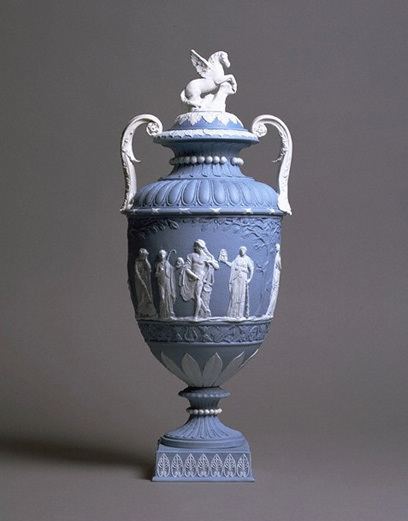 | ||
Jasperware, or jasper ware, is a type of pottery first developed by Josiah Wedgwood in the 1770s. Usually described as stoneware, some authorities have described it as a type of porcelain. It is noted for its matte and unglazed biscuit finish and is produced in a number of different colours, of which the best known is a pale blue that has become known as Wedgwood Blue. Relief decorations (typically in white but also in other colours) are characteristic of Wedgwood jasperware. They are produced in moulds and applied to the ware as sprigs.
Contents
Jasperware composition and colours
While named after the mineral jasper, modern analyses indicate that barium sulphate is a key ingredient. Wedgwood had introduced a different type of stoneware called black basalt a decade earlier.
Jasperware's composition varies but proportions may be given as follows: sulphate of barytes 150, china clay 35, blue clay 45, flint 35, gypsum 6, and Cornish stone 50. It is white by nature but stained with metallic oxide colors; its most common shade in commerce is pale blue, but dark blue, lilac, sage green, black, and yellow are also used, with sage green due to chromium oxide, blue to cobalt oxide, and lilac to manganese oxide, with yellow probably coming from a salt of antimony, and black from iron oxide. The earliest jasper was stained throughout and was known as "solid," but by 1829 production in jasper had virtually ceased. In 1844 production resumed using items coloured only on the surface and known as "dip." Solid jasper was not manufactured again until 1860.
Wedgwood designs
Jasperware is particularly associated with the neoclassical sculptor and designer John Flaxman Jr who began to supply Wedgwood with designs from 1775. Flaxman mostly worked in wax when designing for Wedgwood. The designs were then cast: some of them are still in production.
Sir William Hamilton's collection of ancient Greek vases was an important influence on Flaxman's work. These vases were first known in England from D'Hancarville's engravings, published from 1766. Inspiration for Flaxman and Wedgwood came not only from ancient ceramics, but also from cameo glass, particularly the Portland Vase which was brought to England by Sir William Hamilton. The vase was lent to Wedgwood by the third Duke of Portland. Wedgwood devoted four years of painstaking trials at duplicating the vase - not in glass but in black and white jasperware.
Date markings
Wedgwood jasperware can often be dated by the style of potter's marks, although there are exceptions to the rules:
Other jasperware
Jean-Baptiste Stahl developed his own style and techniques during his work at Villeroy & Boch in Mettlach, Saar, Germany. The name Phanolith was coined for this kind of jasperware. His work is praised for the translucency of the white porcelain on a colored background. JBS's work is known for its refined modelling and the vibrancy of its figures. He thus combined the benefits of jasperware and pâte-sur-pâte. A stand at the World's Fair 1900 in Paris was the first major public presentation of his work and gained him a gold medal. For this event, two huge wall plates were created with dimensions of 220 cm x 60 cm, each.
Spain
The Real Fabrica del Buen Retiro in Madrid produced jasperware. At the end of the eighteenth century jasperware plaques were used in the decoration of the Casita del Príncipe.
